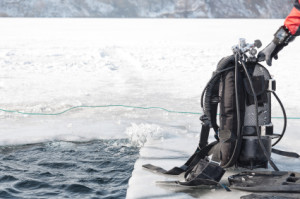 It is bracing cold outside and time for a zero dark thirty workout. Like most mornings my training buddy and I are the first to arrive. We converge at the fitness center entrance without words, grab a half cup of black coffee from the courtesy table and bolt for the sauna. Still bundled up in coats, hats and gloves we defrost for a few minutes on the inside and outside before peeling off layers and making our way to the gym floor. Although we are now acclimated to moderate indoor temperatures, the sauna is an unconventional first stop, not recommended for everyone, and definitely not a complete warm up. We move on to the treadmills where this winter warm up for divers begins with aerobic exercise focusing on the areas of the body to be trained.
It is bracing cold outside and time for a zero dark thirty workout. Like most mornings my training buddy and I are the first to arrive. We converge at the fitness center entrance without words, grab a half cup of black coffee from the courtesy table and bolt for the sauna. Still bundled up in coats, hats and gloves we defrost for a few minutes on the inside and outside before peeling off layers and making our way to the gym floor. Although we are now acclimated to moderate indoor temperatures, the sauna is an unconventional first stop, not recommended for everyone, and definitely not a complete warm up. We move on to the treadmills where this winter warm up for divers begins with aerobic exercise focusing on the areas of the body to be trained.
All warm ups should begin low and slow gradually working up to increases in breathing and heart rate over a period of 10 to 15 minutes. The easiest way to accomplish this is to walk beginning at a pace of 1.5 miles per hour and increasing to 3.0 miles per hour. Warming up prepares the body (including the heart, blood vessels, lungs and muscles) for the more intense exercise of the workout session, helps to prevent injury during exercise, and reduce soreness that some divers may experience after exercise.
More specifically, according to the American College of Sports Medicine, moving the body through a gradual progression utilizing large muscles increases blood flow to muscles, increases the speed of nerve impulses, enhances the flow of oxygen to muscles and removal of waste products. This preparation of the body enhances performance during the workout. Also during this warm up synovial fluid (an oily substance in the joints) changes in response to exercise lubricating the joints. Divers with respiratory conditions or allergies may find a longer warm up helps prevent exercise induced asthma.
Divers who participate in group exercise may be accustomed to warm ups consisting of a low intensity sampling of the same movements that will be performed during the class. During strength training workouts, even after a pre-workout warm up, it is recommended that the first set of each exercise be performed with less weight before performing working sets at higher intensity. Stretching by itself is not a warm up, but may be performed afterward.
A cool down period of gradually decreasing exercise is just as important as the warm up. Again, aerobic exercise at a low intensity works well. This is also a great time to stretch, mediate and then perhaps enjoy a short sauna. Remember to bundle up if it is cold outside. Leaving the gym sweaty makes the body work harder to maintain its normal temperature.
Exercising Outdoors in Cold Temperatures. It is even more important to warm up before exercising outdoors in cold temperatures. Begin with a walk or gentle calisthenics before running, cross country skiing or other winter sports activities. Never stretch when the body is cold. Divers who enjoy snowboarding and downhill skiing may have the option of warming up in a resort fitness facility before hitting the slopes. Stay as warm as possible without overheating before, during and after these activities. Stay well hydrated before, during and after exercise and recreational activities in cold weather.
Dress in layers with a quick dry base close to the body. Protect hands, head, feet and face from the extreme temperatures. Exercising in cold temperatures may not be recommended for divers with heart and respiratory conditions.
Remember diving is not a workout. Ice diving (as shown in this cool photograph) requires special protection from the elements and unique safety protocols. It is highly recommended that divers who enjoy diving in extreme environments achieve and maintain a high level of physical fitness.
Calories Burned in Cold Temperatures. The body utilizes slightly more energy to regulate normal body temperature in cold environments such as diving in cold water. However the additional calories from temperature are negligible. Exercise exertion, which during diving is to be avoided as much as possible, is what produces higher calorie burn. Generically speaking, a diver utilizes approximately 300 calories during a typical dive – about the same as going for a moderate to fast walk for an hour.
 This recipe can be made with almost any ingredients you enjoy eating, but I recommend sticking with a healthy version with lots of vegetables. Use a large pot and freeze portions for later use.
This recipe can be made with almost any ingredients you enjoy eating, but I recommend sticking with a healthy version with lots of vegetables. Use a large pot and freeze portions for later use.


 It is bracing cold outside and time for a zero dark thirty workout. Like most mornings my training buddy and I are the first to arrive. We converge at the fitness center entrance without words, grab a half cup of black coffee from the courtesy table and bolt for the sauna. Still bundled up in coats, hats and gloves we defrost for a few minutes on the inside and outside before peeling off layers and making our way to the gym floor. Although we are now acclimated to moderate indoor temperatures, the sauna is an unconventional first stop, not recommended for everyone, and definitely not a complete warm up. We move on to the treadmills where this winter warm up for divers begins with aerobic exercise focusing on the areas of the body to be trained.
It is bracing cold outside and time for a zero dark thirty workout. Like most mornings my training buddy and I are the first to arrive. We converge at the fitness center entrance without words, grab a half cup of black coffee from the courtesy table and bolt for the sauna. Still bundled up in coats, hats and gloves we defrost for a few minutes on the inside and outside before peeling off layers and making our way to the gym floor. Although we are now acclimated to moderate indoor temperatures, the sauna is an unconventional first stop, not recommended for everyone, and definitely not a complete warm up. We move on to the treadmills where this winter warm up for divers begins with aerobic exercise focusing on the areas of the body to be trained.